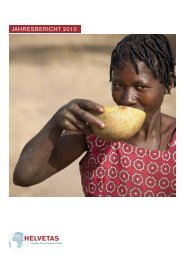Report Feasibility study organic bitter tea Cao Bang - Helvetas
Report Feasibility study organic bitter tea Cao Bang - Helvetas
Report Feasibility study organic bitter tea Cao Bang - Helvetas
You also want an ePaper? Increase the reach of your titles
YUMPU automatically turns print PDFs into web optimized ePapers that Google loves.
<strong>Feasibility</strong> Study Organic Bitter Tea in <strong>Cao</strong> <strong>Bang</strong>: 2007<br />
but also in Syria and Lebanon. Ilex guayusa is used both as a stimulant and as an admixture<br />
to the hallucinogenic <strong>tea</strong> "ayahuasca". The leaves of I. guayusa have the highest caffeine<br />
content of any known plant in the world. In North and Central America, Ilex vomitoria was<br />
used by the Native American Indians as a ceremonial stimulant and emetic known as the<br />
"black drink". As the name suggests, the <strong>tea</strong>'s purgative properties were one of its main<br />
uses, most often ritually. (Wikipedia)<br />
Research at the Triet Giang Agriculture University in China found that there are 16 amino<br />
acids belonging to saponin compounds in fresh <strong>bitter</strong> <strong>tea</strong> leaf. These amino acids strengthen<br />
the metabolic process in the human body and are closely related to the body’s nutrition<br />
structure. Other scientific investigations defined that leaves and buds from <strong>bitter</strong> <strong>tea</strong> contain<br />
many ingredients that can effectively:<br />
reduces blood lipid and cholesterol levels<br />
regulates blood pressure<br />
enhances bile excretion<br />
has a tranquillizer effect<br />
assists heart function, and inflammation relief<br />
has a detoxifying effect, and alcoholic toxin relief<br />
stimulates digestion<br />
have a diuretic effect<br />
In China, Ku Ding Cha has been known for hundreds of years and was first described in<br />
1765 in the "Bencao Gangmu Shiyi". One of the main growing locations for Ilex is in<br />
Guangxi Province of south-western China. The oldest Ilex tree is found growing there: it is<br />
about 30 meters high and has grown for centuries. Guangxi has about 1,400 hectare of Ilex<br />
kudingcha trees under cultivation. In 1997 an Institute was established in Guangxi to<br />
research and develop Ku Ding Cha and other local medicinal plants (Dharmananda, 2002).<br />
Ilex kaushue is an evergreen tree species that grows in the natural forests in <strong>Cao</strong> <strong>Bang</strong>. Its<br />
height varies from 20-30m and the diameter is up to 0.6m. The moist, limey and rocky<br />
mountain areas above 600m are suitable for <strong>bitter</strong> <strong>tea</strong> growing. In 1996, Chinese buyers<br />
purchased a vast quantity of fresh <strong>bitter</strong> <strong>tea</strong> leaves and young branches collected from the<br />
<strong>Cao</strong> <strong>Bang</strong> forests, and started intensive production campaigns in China oriented especially<br />
to local and export markets. In Vietnam, national and provincial researchers started<br />
investigations on the medicinal properties of <strong>bitter</strong> <strong>tea</strong>. Moreover, large cultivation and<br />
reforestation with this evergreen tree could help protect watershed areas, the soil and the<br />
environment. Since <strong>Cao</strong> <strong>Bang</strong> has large areas of forestland and a favourable climate for<br />
<strong>bitter</strong> <strong>tea</strong> growing, the tree has been considered as a potential cash crop to help <strong>Cao</strong> <strong>Bang</strong><br />
farmers escape from poverty.<br />
The Vietnamese government, particularly the <strong>Cao</strong> <strong>Bang</strong> provincial authorities,<br />
then started with a <strong>bitter</strong> <strong>tea</strong> plantation project program (under DOST) and the<br />
opening of a factory in <strong>Cao</strong> <strong>Bang</strong> (the BTC under DOST). The province has<br />
invested in the development of <strong>bitter</strong> <strong>tea</strong> plantation, processing and marketing.<br />
<strong>Cao</strong> <strong>Bang</strong> <strong>bitter</strong> <strong>tea</strong> has gradually become well-known particularly in the local<br />
market and apparently also has a high potential for the export market (EU,<br />
Japan and Korea). However, these markets have not been targeted very<br />
intensively yet, mainly because of a lack of <strong>bitter</strong> <strong>tea</strong> supply (which does not<br />
- 2 -










